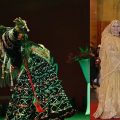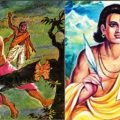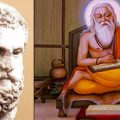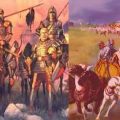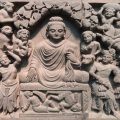Maṇḍana Misra: His Birth, Places where He Debated and the Peethas
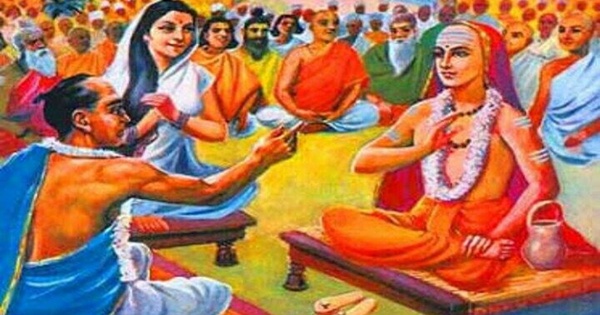
(Contents-Time of Śankara, Kumārila Bhaṭṭa, Mandana Misra.
Gotra, pravara, veda of Maṇḍana, his origin and location.
His debate and later migrations of associate families-to Śṛngeri, Dwaraka.)
Time of Birth – From Prāchīna-Śankara-Digvijaya of Ānandagiri –
तिष्ये प्रयात्यनल शेवधि-बाण-नेत्रे (२५९३) ऽब्दे नन्दने दिनमणावुदगध्वभाजि।
राधेऽदितेरुडुविनिर्गत मंग लग्ने स्याहूतवान् शिवगुरुः स च शंकरेति॥
(प्राचीन शंकर दिग्विजय, आनन्दगिरि-नारायण शास्त्री-Age of Shankara)
Tiṣya = kali, prayāti = passes, nandana varṣa, sun in northern motion and in north hemisphere, Rādhe = in Vaiśākha month (Anurādhā = nakṣatra after Rādhā = Viśākhā), Aditeh uḍu = Punarvasu nakṣatra ruled by Aditi), Manga lagne= in Dhanu lagna, Śivaguru named his son as Śankara. Accordingly, his birth time and horoscope is as follows-
Śankarāchārya at Kālaţī 10040’ north, 760 east, on 4-4-509 BC, Tuesday, 2252 hrs LMT, vaiśākha śukla 5 till 1132 hrs, Punarvasu star from 4-4-509 BC -0139 hrs till 5-4-509, 0406 hrs. Lagna-261024’, Sun-25038’, Moon-90068’, Mars-305019’, Mercury-44034’, Jupiter-247045’, Venus-67053’, Saturn-343022’, Rāhu-31047’.
It may be noted that Jupiter was in Dhanu at that time and only at midnight time it could be in Lagna, not at noon time. That is due to mis-interpretation of Udagadhvabhāji = in north path and part. It does not mean sun at highest point at noon time.
Bṛhat-Śankara-Digvijaya of Chitsukhāchārya gives the same date, but Karka lagna at noon time in Abhijit muhūrta- बृहत् शंकर दिग्विजय, चित्सुखाचार्य-
ततः सा दशमे मासे सम्पूर्ण शुभलक्षणे, षड् विंशे शतके श्रीमद् युधिष्ठिर शकस्य वै।
एकत्रिंशे ऽथ वर्षे तु हायने नन्दने शुभे, मेषराशिं गते सूर्ये वैशाखे मासि शोभने॥
शुक्लपक्षे च पञ्चम्यां तिथ्यां भास्करवत्सरे, पुनर्वसु गते चन्द्रे लग्न कर्कटकाह्वये।
मध्याह्नेचाभिजिन्नाम मुहूर्ते शुभवीक्षिते, स्वोच्चस्थे केन्द्रस्थे च गुरौ मन्दे कुजे रवौ॥
निजतुङ्गगते शुक्रे रविना संगते बुधे, प्रसूता तनयं साध्वी गिरिजेव षडाननम्।
Jinavijaya mahākāvya describes life of Kumārila Bhaṭṭa, his education and opposition of Jaina Guru Kālakāchārya of Ujain (599-527 BC). He was called Vīra for reviving the tradition of last Tīrthankara Mahāvīra (11-3-1905 BC, Kali year 1197, Chaitra śukla 13) Vīra samvat starts from his birth year, but is misunderstood to be of Bhagvān Mahāvīra. This book uses Yudhiṣṭhira śaka from 2634 BC = 504 year of Pāṇḍava Yudhiṣṭhira. This could be original name of 23rd Tīrthankara Pārśvanātha, king of Kāśī, 8 generations after Pāṇḍava Yudhiṣṭhira or he could be famed like Yudhiṣṭhira in following Dharma. Start of this Jaina year could be from date of his sanyāsa or nirvāṇa. This was the period just after drying of Sarasvatī and destruction of Hastināpur in floods of Gangā. This tells birth of Kumārila Bhaṭṭa in year 2634 – 2077 = 557 BC in Krodhī samvatsara. It tells birth of Śankarāchārya 48 years after him in 509 BC. At age of 15, Śankarāchārya met Kumārila Bhaṭṭa when he was immolating himself in fire in Prayaga on Ganga bank.
ऋषि-वारस्तदा पूर्णम् मर्त्याक्षौ वाम मेलनात्, एकीकृत्य लभेद् अंकः क्रोधी स्यात् तत्र वत्सरः।
भट्टाचार्य कुमारस्य कर्मकाण्डैक वादिनः, ज्ञेयम् प्रादुर्भवः तस्मिन् वर्षे यौधिष्ठिरे शके॥
(जिन विजय महाकाव्य, जैन युधिष्ठिर शक ४६८ कलि = २६३४ ईसा पूर्व से)
अष्ट चत्वारि वर्षाणि जन्मकालाद् गतानि वै। प्रादुर्भवः शंकरस्य ततः जातो ऽतिवादिनः॥
पश्चाद् पञ्चदशे वर्षे शंकरस्य गते सति, भट्टाचार्य कुमारस्य दर्शनं कृतवान् शिवः॥
जिनानामन्तकः साक्षाद् गुरुद्वेष्टा ऽतिपापवान्।
Same year and date is given in Vyāsāchalīya (4/20-21) whose second verse is in Mādhavīya Śankara-Digvijaya (2/71) also-
व्यासाचलीय (४/२०-२१)
अब्दे कलेः अनल वर्षशराक्षि संख्ये, श्रीनन्दने दिनमणौ उदगध्वभाजि।
राधेऽधि पञ्चमितिथौ असितेतरायम्, वारेरवेः अदितिभे शुभयोगयुक्ते।
लग्ने शुभे शुभयुते सुषुवे कुमारम्, श्रीपार्वतीव सुखिनी शुभवीक्षिते च।
जाया सती शिवगुरोः निजतुंगसंस्थे, सूर्ये कुजे रवियुते च गुरौ च केन्द्रे॥ (माधवीय शंकर दिविजय २/७१ भी)
Dwārakā Pīṭha also records same date-
द्वारका पीठ-युधिष्ठिर शकस्य द्विसहस्र-षट् शतोत्तरिक-त्रिंशत्तमे अब्दे वैशाख शुद्ध पञ्च (२६३१ युधिष्ठिर शक) म्याम् श्रीमान् महेशज्ञानावतारः अबभूवेति।
Govardhana Pīṭha at Jagannātha Purī was set up in Yudhiṣṭhira śaka 2655-
जगन्नाथ पुरी गोवर्धन मठ प्रतिष्ठा-भूतेन्द्रियङ्ग नेत्राब्दे युधिष्ठिर शकस्य वै। वैशाखे शुक्ल पक्षे च दशम्यां शोभने दिने। (युधिष्ठिर शक २६५५, वैशाख शुक्ल दशमी)
Hāla Śātakarṇī @ Pūrṇavarmā (494-489 BC) was contemporary. He was ruling in Magadha when Śankarāchārya met Kumārila Bhaṭṭa-
हाल शातकर्णी (पूर्णवर्मा) (४९४-४८९ ईसा पूर्व)
ब्रह्म सूत्र (२/१/१८)-शंकर भाष्य-न हि वन्ध्या पुत्रो राजा बभूव, प्राक् पूर्णवर्मणः अभिषेकात् इति जातीयकेन मर्यादा।
वायु पुराण -ततः संवत्सरम् पूर्णः हालोराजा भविष्यति।
गुरुरत्नमाला-अपि हाल नृप-पालितम् द्रागपहयेन्द्र हरिन्मुखम् वितन्द्रम्। श्रित मुर्मुरम् उद्धरन् त्रिवेण्याम् यतिराड् भट्टमघानि वो वितृण्यत्॥ (१५/१)
व्याख्या-हाल नृपालेन तदभिधानेन मगधमहिपतिना।
मठाम्नाय सेतु-सुधन्वाद्या महाराजा हालाद्यश्च महीश्वरः, धर्म पारम्परामेतम् पालयन्तु निरन्तरम्।
Gotra-Pravara-Veda etc
From Jāti-Bhāskara, Brāhmaṇotpatti-mārtaṇḍa
Kumārila Miśra Maṇḍana Miśra Jaimini-vamśa
(s/o Viṣṇu Miśra, Bhaṭṭa =Mīmānsaka) (S/o Hima Miśra) (Purohita of Maṇḍana)
Gotra Kauśika Avigata (Dhṛta- Kauśika) Kaśyapa
Bhṛgu (Bhūrbhuvah)
Śākhā Mādhyandinī Kaṇva (Mādhyandinī) Kauthumī
Sūtra Parāśara Kātyāyana Gobhila
Veda Śukla Yajurveda Śukla Yajurveda Sāmaveda
Upaveda Dhanurveda Dhanurveda Gandharva
Pravara Devarāta Devarāta, Ajīgarta, Tri (Kaśyapa,
Ādhamarṇya, Kauśika (Dhṛta Kauśika) Kauśika Asita, Devala)
Kuladevatā Śiva Śiva Viṣṇu
Śikhā Vāma Vāma Vāma
Pāda Dakṣiṇa Dakṣiṇa Vāma
तं मण्डनं सस्मित जैमिनीक्षितं व्यासोऽब्रवीज्जल्पसि वत्स दुर्वचः।
आचारणा नेयमनिन्दितात्मनां ज्ञातात्मतत्त्वं यमिनं धुतैषणम्॥ (माधवीय शंकर दिग्विजय ८/३३)
Books by Maṇḍana Miśra–
(a) Before sanyāsa-
Vidhi Viveka-Description of Karma kāṇḍa
Bhāvanā Viveka-Niṣkāma and sakāma anuṣṭhāna.
Vibhrama Viveka – Prātibhātika and Vyāvahārika satya.
Mīmānsā sūtrānukramaṇī
Sphoṭa siddhi-Śabda Brahma
Brahma siddhi- Advaita tattva.
Śloka Vārtika Ṭīkā-on book by Kumārila Bhaṭṭa.
Bṛhat Kathā-Its Mādrivatī-kathā has been written as Mālatī-Mādhava by Bhavabhūti who has stated this to be work of Kumārila Bhaṭṭa disciple Viśvarūpa (Maṇḍana Miśra).
Adbhut Rāmāyaṇa-Sītā as daughter of Mandodarī, tested in water instead of fire.
(b) After sanyāsa-
Naiṣkarmya siddhi.
Vārtikas on Śankara-Bhāṣyas of Bṛhadāraṇyaka and Taittirīya upaniṣad.
Mānasollāsa-Prasankhyāna (Bhakti).
Pañchīkaraṇa Vārtika-Samprajñāta and Asamprajñāta samādhi.
Kāśīmṛta Mokṣa Vichāra.
Bālakrīḍā-Description of Bāla-Kṛṣṇa worshipped by Śankara.
Viśvarūpa Samucchaya-His kuladevatā, Veda, Śākhā etc. That is summarized in above chart.
Śrāddha Kalikā-16 samskāras, muhūrta.
Original place of Mandana Misra
At every place his village has been stated in Magadha on banks of Son river whose names Śoṇa and Hiraṇyabāhu are pullinga by exception (also Brahmaputra river) all other river names are strīlinga. It had sal forest around it. Natural habitat of sal forest is sub-Himalayan region only, but due to peculiar rock and climate a thin branch of sal forest has come to south starting from Gorakhpur, Vārāṇasī (Sarnath), Sasaram (Sahasra-rāma, place of Paraśurāma), Palamu, Sinhbhumi, Sambalpur (Orissa) with south end in Koraput. Here, Śrīrāma had pierced 7 sal trees before killing Bali-that place is Balimela. Family of Maṇḍana Miśra was originally from Dharmamūlā, now Dhramapura in Balia district (in adjacent Basti district now) at east end of Uttar Pradesh. Brāhmaṇas of his gotra still live there. Then, it settled in Vijjalavindu, somewhere between Kāśī and Balia in eastern UP.
His real name was Viśvarūpa and popularly called Umbeka. For explaining Mīmānsā texts including books of his guru Kumārila he was called Maṇḍana (explaining, decoration). After marriage with Bhāratī d/o Viṣṇu Miśra of Māgadhapur on Son river bank, he stayed there itself. At many places, it is written that Bhāratī was sister of Kumārila Bhaṭṭa. She was also called Umbā as incarnation of Sarasvatī and her husband Umbeka. After sanyāsa, he was named Sureśvara and was made first head of Śṛngerī Pīṭha in south. But, situation in Dwārakā was tough due to strong presence of Bauddhas from Gujrat, Sindh to Bāhlika and strongest man Sureśvarāchāya was sent there to counter them. North west part was always under attack of Asuras from west, so Gurjara faced maximum damage to Vedic knowledge as stated in birth of Bhakti with sons knowledge and un-attachment-
अहं भक्तिरिति ख्याता इमौ मे तनयौ मतौ। ज्ञान वैराग्यनामानौ कालयोगेन जर्जरौ॥४५॥
उत्पन्ना द्रविडे साहं वृद्धिं कर्णाटके गता। क्वचित् क्वचित् महाराष्ट्रे गुर्जरे जीर्णतां गता॥४८॥
तत्र घोर कलेर्योगात् पाखण्डैः खण्डिताङ्गका। दुर्बलाहं चिरं जाता पुत्राभ्यां सह मन्दताम्॥४९॥
वृन्दावनं पुनः प्राप्य नवीनेव सुरूपिणी। जाताहं युवती सम्यक् श्रेष्ठरूपा तु साम्प्रतम्॥५०॥
(पद्म पुराण उत्तर खण्ड, श्रीमद् भागवत माहात्म्य, भक्ति-नारद समागम नाम प्रथमोऽध्यायः)
When Mandana Misra and some associated families accompanied Śankarāchārya to south, many families returned back to original place Dharmapura in Balia. After 12 generation, his descendant Navaguṇī Miśra was given title of Upādhyāya by king of Kāśī and they came back to Māgadhapur and renamed it as Maṇḍanapur in memory of their famous predecessor. His descendants are still in that village, Rajagarh (palace of Maṇḍana Miśra). These villages are in Sahar PS of Bhojpur district. Purohitas of this family were of Jaimini gotra residing in Kantita-patarah of Sivan district in west Bihar (bordering Balia of UP). Maṇḍana Miśra family requested them to settle nearby village named Anantapur after famous saint Ananta Tiwari (Ananta Baba). All places of Kuladevatā, Jaṭā devī etc still exist there. Place of debate was called Vijitapur (Vijita =conquered), now called Bajitpur villace nearby. Place of yajña is Angora kṣetra, boat place is Dondi (local name for boats), Bhudava, Bharati-bhara is place of pond named after Bhāratī. Place of gathering of scholars is called Daṇḍī kṣetra, place of paddy fields is Khili -Tāṇḍa (both mean outskirts, Khili also means paddy husk in local language), Jaṭā Devī kṣetra who has 2 stone idols, 4 Kāla-Bhairava.
Mīmānsakas fight in debate to prove their point, they are Bhaṭa (warriors) of this war, so they were called Bhaṭṭa. like the most famous Kumārila. Person who spread Ārya (of Brahmā) mata of astronomy was called Āryabhaṭa (360 kali, changed to 3600 by British).
It may be noted that Sone river was eastern boundary of old Kāśī janapada. As Kāśī was called Hiraṇya-garbha (center of Bharata in time of Divodasa, Deva period), its boundary river was called Hiraṇya-bāhu. It is central place of Śiva and separate rules as old capital. Till today, vartate verb is used here, other parts use Asti. Invisible form of Śiva appeared as pillar of fire (agni-stambha) on request of Viṣṇu and Brahmā. Agni has 8 forms as vasu, so there are 8 Agni-grāmas in 8 directions from Kāśī. One of them-Agiaon is near Maṇḍanapur.
हिरण्यगर्भः समवर्तताग्रे भूतस्य जातः पतिरेक आसीत्। स दाधार पृथिवीं द्यामुतेमां कस्मै देवाय हविषा विधेम॥
(ऋक् १०/१२१/१, वाजसनेयी यजुर्वेद १३/४, २३/१, अथर्व ४/२/७)
However, after Śiśunāga vamśa, Kāśī and Magadha were joined and hence this state has been called Magadha. Then Magadha was under rule of Āndhra king Hāla (494-489 BC). Most of the country appears to be under Chahman king Sudhanvā in 6th generation of Chāhman who had tronced Asura (Asyrian) capital Nineve in 612 BC indicated at several places in old testament. Then Chāhman śaka started as indicated in Bṛhat-samhitā (13/3) of Varāhamihira.
Some relevant passages are quoted below about Sone river, sal forest and Magadh. It is surprising that these verses have been quoted by groups trying to show his birth place near Ujjaini or Mahishi village in Saharsa district of Mithila region in north Bihar, without even understanding the names indicated there.
सदा वदनभोग पदं च साम्प्रतं स विश्वरूपः प्रथितो महीतले।
महागृही वैदिक कर्म तत्परः प्रवृत्तिशास्त्रे निरतः सुकर्मठः॥ (माधवीय शंकर दिग्विजय, ९/११४)
शिष्यो ममास्ति मगधेषु स विश्वरूपो, भूमौ प्रसिद्ध सगुणोऽखिल शास्त्रवेत्ता।
वाक्यं तदीयमनुमत्य ततः प्रयान्तं, योगीन्द्रमैक्षत स मण्डन मिश्र विद्वान्॥
आश्वास्यतं च मगधं गतवान् ददर्श, तं विश्वरूप गृहिणं विबुधाग्रगण्यम्॥ (गुरुवंश काव्य २/४५, ४७,५०)
चार्वाक दर्शन विधान सरोषधातृ शापेन सम्प्रति शतक्रतु देशिकेन्द्रः।
द्योतते मगधसीमनि विश्वरूप नामा समस्तनय सागर पारदर्शी॥
उम्बेक इत्यभिहितस्य हितस्य लोके उम्बेति बान्धवजनैरभिधीयमाना।
शप्ता सरोरुह भवेन सरस्वती सा जाता वधूरुभय भारतिकाभिधाना॥
सर्वासु शास्त्र सरणीषु स विश्वरूपो मतोऽधिकः प्रियतमश्च ममाश्रयेषु।
यदा प्रणम्यो पशशाम शंकरे स भट्टनामा मरणाय दीक्षितः।
तत् पार्श्ववर्ती विदितार्त संग्रहः स मण्डनाख्यो ऽभिजगाम शंकरम्॥
(शंकर विजय मकरन्द, १५/१०८, १०९, ११०, ११४)
कुमारिले सूर्य इतेऽस्त लोक व्याप्तेऽन्धकारे परितो दिशासु।
श्री शंकराचार्य उदारबुद्धिः विचारयन् वाञ्छित धर्मकार्यम्॥
उद्विग्नचेतापि स तूर्णपादः श्रीमण्डन द्योत विदिष्ट मार्गः।
धावन्निवाग्रे मनसा यतीन्द्रश्चचाल मगधं प्रतिमण्डनस्य॥ (श्री शंकराचार्य चरितम् , ८/१३-१४)
अयं च पन्थाः यदि ते प्रकाश्यः सुधीश्वरो मण्डन मिश्र शर्मा।
दिगन्त विश्रान्त यशा विजेयो यस्मिञ्जिते सर्वमिदं जितं स्यात्॥
ऊम्बेक इत्यभिहितस्य हि तस्य लोकैरुम्बेति बान्धवजनैरभिधीयमाना।
हेतोः कुतश्चिदिह वाक् सुरुषाऽभिषप्ता दुर्वाससाऽजनि वधूर्द्वयभारतीति।
सर्वासु शास्त्रसरणीषु स विश्वरूपो मतोऽधिकः प्रियतमश्च मदाश्रवेषु।
तत् प्रेयसी शम धनेन्द्र विधाय साक्ष्ये वादे विजित्य तमिमं वशगं विधेहि॥
(माधवीय शंकर दिग्विजय, ७/११३, ११६-११७)
ततः स सम्प्राप्य सुरेश्वराख्यां दिगङ्गनाभिः क्रियमाणसंख्याम्।
सच्छिष्यतां भाष्यकृतश्च मुख्यामवाप तुच्छीकृत धातृ सौख्यम्॥
निखिल निगम चूडाचिन्तया हन्त यावत्, स्वमनवधिक सौख्यं निर्विशन्निर्विशङ्कम्।
बहुतिथमभितौऽसौ नर्मदां नर्मदां तां मगधभुवि निवासं निर्ममे निर्ममेन्द्रः॥
(माधवीय शंकर दिग्विजय, १०/१०४, १०५)
(Here Narmadā is not name of a river in context of Magadha, it is adjective of Bhāratī)
इति वशीकृत मण्डन पण्डितः प्रणतसत्करणत्रयदण्डितः।
सकल सद्गुण मण्डल मण्डितः स निरगात् कृत दुर्मत खण्डितः॥ (१०६)
सत्यं यदात्थ विनयिन् मम याजुषी या शाखा तदन्तगत भाष्यनिबन्ध इष्टः।
तद् वार्तिकं मम कृते भवता प्रणेयं सच्चेष्टितं परहितैक फलं प्रसिद्धम्॥
तद्वत्त्वदीया खलु काण्वशाखा ममापि तत्रास्ति तदन्त भाष्यम्।
तद्वार्तिकं चापि विधेयमिष्टं परोपकाराय सतां प्रवृत्तिः॥ (माधवीय शंकर दिग्विजय, १३/६५-६६)
अथ प्रतस्थे भगवान् प्रयागात्तं मण्डनं पण्डितमाशु जेतुम्।
गच्छन् खसृत्या पुरमालुलोके महिष्मतीं मण्डन मण्डितां सः॥ (माधवीय शंकर दिग्विजय, ८/१)
(Town graced by Mahiṣī = Bhāratī and Maṇḍana)
यस्याः पुरा राजति धर्ममूला, या क्षालयन्ती चरणौ सदाऽस्याः।
महिष्मतीं मण्डन मण्डिता सा, यत्रास्ति तारा भुवनस्य तारा॥
(महाचीन कर्म, पटल २२ शंकर विजय मकरन्द, १६/१०-१७)
(Town on banks of Dharmamūlā was graced by Maṇḍana, where there is Tārā Pīṭha)
स महिषी मण्डनाभ्यां मण्डितं अलंकृतं पुरं नगरम्, आलुलोकं आ समन्तात् अवलोकितवान्। (विद्यारण्य टीका)
सा शोणतीरे ऽजनि विप्रकन्या सर्वार्थवित् सर्वगुणोपपन्ना।
यस्या बभूवुः सहजाश्च विद्याः शिरोगतं के परिहर्तुमीशाः॥
शोणस्य तीरमुपयात मुपाशृणोत् स जामातरं बहुविधं किल विष्णुमित्रः।
प्रत्युज्जगाम मुमुदे प्रियदर्शनेन प्रावीविशद् गृहममुं बहु वाद्य घोषैः॥ (माधवीय शंकर दिग्विजय, ३/१५, ४९)
त्यक्ष्यामि नाहं व्रतमात्म भीनं त्वं मण्डन मिश्र अथ प्रयाहि।
विद्योतते मगधसीमनि विश्वरूप नामा समस्तनय सागर पारदर्शी॥ (शंकराचार्य चरितम् २/११)
अथ सा भारती जज्ञे शोणतीरे द्विजन्मनः।
तनया विष्णुमित्रस्य सर्वांग मधुरा सती॥ (शंकर विजय मकरन्द, १६/४)
विद्योतते मगधसीमनि विश्वरूपनामा समस्तनय सागर पारदर्शी। (शंकर विजय मकरन्द, १५/१०८)
पाणिग्रहात् स्वाधिपतौ समीरितौ पुरा कुमार्याः पितरौ ततः परम्।
पतिः तमेकं शरणं ब्रजानिशं लोकद्वयं जेष्यसि येन दुर्जयम्॥(माधवीय शंकर दिग्विजय, ३/७०)
भूभृन्निकेतनगतः श्रुतविश्वशास्त्रः श्री विश्वरूप इति यः प्रथितः पृथिव्याम्।
तत् पादपद्मरजसे स्पृहयामि नित्यं, साहाय्यमत्रयदि तात भवान् विदध्यात्॥ (माधवीय शंकर दिग्विजय, ३/२८)
(Here Bhūbhṛt = hill, niketana = house-high rise palace, rich like a king. In verse below also it is told like palace of Indra)
तदा स लेखेन्द्र निकेतनाभं स्फुरन् मरुच्चञ्चलकेतनाभम्।
समग्रमालोकत मण्डनस्य निवेशनं भूतलमण्डनस्य॥ (माधवीय शंकर दिग्विजय, ८/१०)
शोणाख्य पुंनदतटे वसतो द्विजस्य कन्या श्रुतिगतवती द्विजपुंगवेभ्यः।
सर्वज्ञता पदमनुत्तमरुपवेषां तामुद्विवक्षति मनो भगवन् मदीयम्॥ (माधवीय शंकर दिग्विजय, ३/२६)
मौहूर्तिकैः बहुभिरेत्य मुहूर्तकाले संदर्शिते द्विजवरैः बहुविद्भिरिष्टैः।
माङ्गल्यवस्तु सहितो ऽखिलभूषणाढ्यः सप्रापदक्षत तनुः पृथुशोणतीरम्॥
शोणस्य तीरमुपयातमुपाशृणोत् स जामातरं बहुविधं किल विष्णुमित्रः।
प्रत्युज्जगाम मुमुदे प्रियदर्शनेन प्रावीविशद् गृहममुं बहुवाद्यघोषैः॥ (माधवीय शंकर दिग्विजय, ३/४८, ४९)
जग्राह पाणिकमलं हिममित्रसूनुः श्री विष्णुमित्रदुहितुः करपल्लवेन। (माधवीय शंकर दिग्विजय, ३/५७)
प्रफुल्ल राजीववने विहारी तरङ्गरिङ्गत् कण शीकरार्द्रः।
रेवामरुत् कम्पित सालमालः श्रमापहृद् भाष्यकृतं सिषेवे॥ (माधवीय शंकर दिग्विजय, ८/३)
(Here Revā marut means westerly wind which is strong enough to shake sal trees)
Places of Debate and Pīṭhas
Ānandagiri in his Śankara-vijayam, page 101 has given list of places in Digvijaya of Śankarāchārya-
Ananta-Sayana (Tiru-ananta-pura) Nīlakaṇṭha kṣetra
Anumallapura Prayāga
Ayodhyā Badarī kṣetra
Ahobila Vijila-vindu
Indraprasthapura Madhyārjuna
Ujjayinī Marundhapura
Kāñchī Māgadhapura (Maṇḍanapura)
Kālaṭī Yamaprasthapura (could be in Persia)
Kāśī Rāmeśvara
Kurukṣetra Rudranagara
Kedāra Vidhāla
Kailāsa Venkaṭagiri
Gaṇavara Vyāghrapura (Buxar=Vyāghrasara in Bihar)
Gayā Śṛngagiri
Jagannātha Śrīśaila
Tulajābhavānīpura Subrahmaṇya kṣetra
Dvārakā
Śankarāchārya had gone up to Bāhlīka (in Persia now) and Sindha, Kasmir (Sarvajña-pīṭha), Nepal also. Obviously, he could not have gone to Kashmir, Sindha, Persia in 800 AD when these places had come under Islamic empire.
After debate, Mandana Misra and many of his associate families had gone to Śṛngagiri, Kāñchī-both the places claim him (named Sureśvara) as first head. But order of king Sudhanvā indicates that he had to be made head of Dwārakā Pīṭha to resist destruction by Jaina influence who had already destroyed Trailokyasundara temple built by Vajranābha, great grandson of Bhagavān Kṛṣṇa.
राज्ञः सुधन्वनः ताम्रपत्र-विज्ञप्ति
शी महाकालाय नमः, श्री महाकाल्यै नमः
श्रीमत् सदाशिवा-परावतार मूर्ति चतुष्षष्टि कलाविलास विहारमूर्ति बौद्धादि सर्ववादि दानव नृसिंहमूर्ति वर्णाश्रम वैदिक सिद्धान्तोद्धारक मूर्ति मामकीन साम्राज्य व्यवस्थापनमूर्ति विश्वेश्वर-विश्वगुरु पदम् जगज्जेगीयमान मूर्ति निखिल योगि-चक्रवर्त्ति श्रीमच्छङ्कर भगवत्पाद-पद्मयोः भ्रमरायमाण सुधन्वनो मम सोमवंश चूडामणि युधिष्ठिर पारम्पर्य परिप्राप्त भारतवर्ष स्याञ्जलिबद्ध पूर्विकेयं राजन्यस्य विज्ञप्तिः। भगवद्भिर्दिग्विजयोऽकारि। सर्वे वादिनः पराकृताः। सर्वे वर्णा आश्रमाश्च कृतयुगवत् पूर्णे वैदिकाध्वन् नियोजिताः सन्तो यथाशास्त्रमाचरन्ति हि धर्मम्। ब्रह्म-विष्णु-महेश्वर-महेश्वरी स्थानान्य शेष देशवर्त्तीन्युद्धृतानि। सर्वं ब्रह्मकुलमुद्धारितम्। विशिष्यास्माद्राज्य कुलमान्वीक्षिक्याद्यशेष राजतन्त्र परिशीलने नोन्नीतं भवति। ब्रह्म-क्षत्राद्यस्मत् प्रमुख निखिल विनेय लोक सम्प्रार्थनय् चतस्रो धर्मराजधान्यो जगन्नाथ-बदरी-द्वारका-शृङ्गर्षि क्षेत्रेषु भोगवर्द्धन-ज्योतिश्शारदा शृङ्गेरी मठापर सञ्ज्ञकाः संस्थापिताः। तत्रोत्तर दिशो योगिजन प्राधान्येन धर्ममर्यादा रक्षणं सुकरमेवेति ज्योतिर्मठे श्री तोटकापरनाम्नः प्रतर्दनाचार्यानथ शृङ्गर्ष्याश्रमे शृङ्गर्षि-सम-स्वभावान् पृथ्वीधराभिधेय हस्तामलकाचार्यान् भोगवर्धने स्वत एवाभिमतत्त्वेनात्यन्तोग्र स्वभावानपि सर्वज्ञ-कल्प पद्मपादापरनाम सनन्दनाचार्यानथ बौद्ध-कापालिकादि सकलवादि भूयिष्ठ पश्चिमायां दिशि वादिदैत्याङ्कुरः पुनर्माभवत्विति शारदा पीठे किल द्वारकायां जैनैरुत्सादित वज्रनाभनिर्मित भगवदालयादि दुर्दशां दूरीकृत्य भगवद्भि-स्त्रिलोक-सुन्दर नाम्ना पुनस्सन्निबद्ध भगवदालय श्रीकृष्णादि सकल मर्यादा सुसंस्कृतायामहिगताशेष लौकिक-वैदिक-तन्त्र विश्वविख्यात कीर्ति सर्व-ज्ञान-मयान् विश्वरूपापर नाम सुरेश्वराचार्यांश्चास्म्अत् सर्वलोकाभिमति पूर्वकमभिषिच्यैवं चतुर्भ्य आचार्य्येभ्यश्चतस्रो दिश आदिष्टा भारतवर्षस्य। त एते तत्तत् पीठ प्रणाळ्या निजनिजमेव मण्डलं गोपायन्तो वैदिकमार्गमुद्भासयन्तु। सर्वे वयं तत्तन्मण्डलस्या ब्रह्म-क्षत्रादयस्तत्तन्मण्डलस्यैवाचार्यस्याधि-काराधिकृता वर्तिष्यामहे च। महद्विनिर्णय प्रसक्तौ तु सुरेश्वराचार्य्या एवोक्त लक्षणतः सर्वत्रैव व्यवस्थापका भवन्तु भगवतामनुशासनच्च। अस्मद् राजसत्तेव निरङ्कुश गुरु-सत्ताप्युक्त मर्यादया जगत्यविचलं विचलतु। परिव्राजको हि महाकुलीनत्त्व-वैदुष्यादि विशिष्टाचार्य लक्षणैरन्वित एव श्रीभगवत् पाद पीठानामधिकारमर्हति न तु विनिमयेनेत्येवमादि नियम बन्धो भगवदाज्ञा समवबुद्धस्समस्तैरथास्मदादि ब्रह्म-क्षत्रादि वंशोद्भवैः परम प्रेम्णोत्तमाङ्गेनाद्रियत इत्येतां विज्हप्तिमङ्गीकुर्वत भगवन्त इति स्वस्त्यस्तु लोकेभ्यः। युधिष्ठिर शके २६६३ आश्विन शुक्ल १५।
-सुधन्वा सार्वभौमः
Sudhanvā was descendant of Yudhiṣṭhira as indicated by him in the said order. He must be having direct or indirect control over places of 4 Pīṭhas. In 756 BC, there was a federation of 4 kings under king Śūdraka (his śaka indicated in Jyotiṣa-darpaṇa of Yallaya) at mount Abu under Viṣṇu incarnation Buddha born in Kaśyapa gotra Brāhmaṇa family of Kīkaṭa Magadha).This was famed as Mālava-gaṇa. The 4 kings who led in protection of country against Asura (Assyrian attack) were called Agni (Agrī) vamśī-Paramāra of Ujjain, Pratihāra of Rajsthan, Chālukya (Śukla) of Gujrat-Maharashtra, called Salunkhe, Solanki now, and Chahmāna of Delhi. Since then the Delhi kings were called Chauhan. In 612 BC, this king wiped out Nineve, capital of Asyria, when his śaka started. Sudhanvā was in his 6th generation. Shortly after him, Mālava-gaṇa ended in 456 BC when Śrīharṣa of Ujjain started his era (Rajatarangiṇī, Al Biruni). This has been called 300 years period of democracy by Megasthenes. As per Kathā-sarit-sāgara, Śrīharṣa was one of the sons of Govinda Śarmā, who became Govinda-pāda after sanyāsa and guru of Śankarāchārya. Rule of Sudhanvā family continued up to Pṛthvīrāja Chauhan-3 who was defeated in 1192 AD by Mohammada Ghori. His family chain is given below as compiled by Sri Parameshvarnath Mishra in his book Amiţa-Kāla-Rekhā (Calcutta, 2001)-
(1)Chāhmāna, (2) Sāmantadeva, (3) Mahādeva, (4) Kubera, (5) Bindusāra, (6) Sudhanvā – He set up 4 Pīţhas of Śankarāchāryas for which an order was issued on copper plate dated 2663 Yudhişţhira śaka (485 BC) on Āśvina śukla 15. (7) Vīradhanvā, (8) Jayadhanvā, (9) Vīrasimha, (10) Varasimha, (11) Vīradaņɖa, (12) Arimantra, (13) Māņikyarāja, (14) Puşkara, (15) Asamañjasa, (16) Premapura, (17) Bhānurāja, (18) Mānasimha, (20) Hanumān, (21) Śambhu, (22) Mahāsena, (23) Suratha, (24) Rudradatta, (25) Hemaratha, (26) Chitrāngada, (27) Chandrasena, (28) Vatsarāja, (29) Dhŗşţadyumna, (30) Uttama, (31) Sunīka, (32) Subāhu, (33) Suratha, (34) Bharata, (35) Sātyaki, (36) Śatrujita, (37) Vikrama, (38) Sahadeva, (39) Vīradeva, (4) Vasudeva, (41) Vāsudeva (king in 551 AD)-his 2 branches started kingdoms. One branch ended with last king of Delhi-Pŗthvīrāja-3 killed in 1192 AD. The other branch had Vīra Gogādeva who fought with Mahmud Gazanavi in desert.
Delhi-Ajmer branch- (42) Sāmanta, (43) Naradeva or Nŗpa, (44) Vigraharāja-1, (45) Chandrarāja-1, (46) Gopendra-rāja or Gopendraka, (47) Durlabha-rāja, (48) Govinda-rāja or Guvaka-1-in time of Pratihāra king Nāgabhaţţa-2. (49) Chandra-rāja-2 (843-868 AD), (50) Govinda-rāja or Guvaka-2 (868-893 AD), (51) Chandana- Govinda-rāja (893-918 AD), (52) Vākpati-rāja-1 (Vappayarai) (918-943 AD), (53 A) Vindhya-rāja-very short period followed by his brother. (53 B) Simha- rāja. He had 4 sons-Vigraha-rāja-2, Durlabha-rāja-2, Chandra-rāja, Govinda-rāja. (54A) Vigraha-rāja-2 (from 973 AD)-He had defeated Mūlarāja of Gujrat and made Āśāpurā temple in Bhŗgu-kacchha. He had sent army in 997 AD to help Lahore king against Subuktagin. (54B) Durlabha-rāja-2 (998 AD), (55) Govinda-rāja-3 (999 AD), (56A) Vākpati-rāja-2 (999-1018 AD), (56B) Vīrya-rāja (1018-1038), (56C) Chāmuņɖa-rāja (1038-1063 AD)-these 2 were brothers of 56A. (57A) Simhala-eldest son of 56C. (57B) Durlabha-rāja-3 (1063-1079 AD)-son of 56C. (57C) Vigraharāja-3 (1079-1098 AD)-brother of 57B. (58) Pŗthvīrāja-1 (1098-1105 AD), (59) Ajaya- rāja (Ajayadeva or Salhana)-(1105-1132 AD)-built Ajmer. (6) Arņorāja (Analdeva, Anna, Anaka)-(1132-1151 AD), (61A) Jagadeva (1151 AD)- He had killed his father Arņorāja for which he was killed by his brother Vigraharāja-4 (61B) Vigraharāja-4 (Viśāladeva)-(1151-1167 AD)-he had defeated Chālukyas. (61C) Someśvaradeva (1169-1177 AD)-Brother of 61B, as Pŗthvīrāja-2-son of 61A had no son. (62A) Apara-Gāngeya or Amara-Gāngeya-son of 61B. (62B) Pŗthvīrāja-2-son of 61A. He defeated 61A and died issueless in 1169 AD. (62C) Pŗthvīrāja-3 (1177-1192 AD)-last Hindu king of Delhi. He defeated Mohammad Ghori in 1191, but was defeated in 1192 AD due to Jayachanda of Kannauj.
Bhaṭṭa Brāhmaṇas
There are Bhaṭṭa Brāhmaṇas in Śṛngagiri (Udupi) and Gujrat. These could be direct descendants of associate families of Maṇḍana Miśra who went first to Śṛngagiri and then to Dvārakā. They could also be followers of Mīmānsā as explained by Kumārila Miśra, called Bhaṭṭa due to debates for vedic path. There are many references of large disciples following Śankarāchārya. King Sudhanvā also accompanied in south with his army of 1000.
राज्ञः सुधन्वनः प्राप नगरीं स जयन् दिशः। प्रत्युद्गम्य क्शितीन्द्रोऽपि विधिवत्तमपूजयत्॥
अथ शिष्यवरैर्युतः सहद्रैरनुयातः स सुधन्वना च राज्ञा।(१/६२)
ककुभो विजिगीषुरेषु सर्वाः प्रथमं सेतुमुदारधीः प्रतस्थे॥१॥
इतिवादिनि भूमिपे सुधन्वा यतिराजं निजगावधिज्यधन्वा।
मयि तिष्ठति किं भयं परेभ्यस्तव बक्ते यतिनाथ पामरेभ्यः॥१०॥
(माधवीय शंकर दिग्विजय)
Chapter 15 of Mādhavīya Śankara Digvijaya states route of Śankarāchārya with Maṇḍana Miśra and other disciples as-
Vijitapura (now Bajitpur in Bhojpur district) after worship of Gupteśvara Mahādeva to Amarakaṇṭaka along Sone river. Then along Narmadā river Māheśvara. Along Vena-gangā to Godāvarī bank at Nasik. At Pandharpur on Bhīmā bank, Śrīśaila on junction of Tungabhadra and Krishna. Gokarṇa, Harishankara, Mūkāmbikā, Śṛngeri. Later on, Sudhanvā’s order states that Maṇḍana Miśra @Sureśvara became head of Dwārakā Pīṭha.
R. Venkatraman in ‘Devi Kamakshi in Kanchi-
“Tradition speaks of the settlement in Kanchi of thirty families from narmada valley, ten of Kaundinya gotra, ten of Kausika gotra and ten of Purukutsa gotra who were all adepts in the vaidika and Agama lores.”
(Here, Kaushika gotra indicates Maṇḍana Misra and associate families who went first to Narmada region).
“The movement of clans and families of Brahmins including Bhattars, or much anterior to the time of Raj Raj Chola 1. The settlers in the south kept up contact with Aryadesha, Varanasi, Gurjaradesha and Kashmir.”
“Vibhaga ratnakara (MS No. R1739 in Madras Govt Oriental Mss Library) traces the history of some Brahmin families from Mandaraka on the Ganga who settled in Kanchi mandalam.”
Tilakadhari Upadhyay in his book “Magadha Mimansaka Mandana Misra, has quoted a letter from Dr. S. Subrahmanya Sastri-“It is not correct to say that there are descendants of Mandana Misra near Trichur. The family that is mistakenly taken to be so is that of Payuur Bhattas. It is due to an incorrect understanding of the passage-Mandana Charyakrtayo yesvatishthanta krtsansasaha- occuring in one of their works. Evidently, the passage means that the works of Mandana Misra were all well established with them, and does not mean that they were his descendants.
Different Buddhas
There are 2 Buddhas in list of 28 – Siddhārtha and Gautama. Both are assumed to be same. 28 Buddhas are described in Chapter 27 of the Buddhavamśa, plus Maitreya Bodhisattva, the future (and 29th) Buddha. The Buddhavamśa is a text which describes the life of Gautama Buddha and the twenty-seven Buddhas who preceded him. The Buddhavamśa is part of the Khuddaka (Kśudraka) Nikāya, which in turn is part of the Sutta (Sūtra) Piţaka. The Sutta Piţaka is one of three main sections of the Pāli Canon of Therāvāda Buddhism.
Siddhārtha was 24th in Ikśvāku family after Mahābhārata starting on 16-10-3139 BC or Kārttika Amāvāsyā. 68 days after that, Bhīşma had died on 24-12-3139 BC when north motion of sun had started. 5 days before that Yudhişţhira had been crowned on 17-12-3139 BC. This date has been indicated by Albiruni and by Abul Fazal who has given concordance of Din-elahi with older calenders. That date of Mahābhārata is also confirmed by 5 inscriptions of Janamejaya in 29th year of his rule in 3014 BC which state all 5 elements of date of Indian calender and solar eclipse of 27-11-3014 BC also is confirmed by calculations. Thus, recorded date of 31-3-1986 BC to 27-3-1807 BC for Siddhārtha Buddha is correct.
Gautama Buddha was following Gautama tradition of verbal logic, so he was called Gautama. The whole Buddhist literature is only verbal logic to counter Gautam’s Nyāya-darśana in his own style. Out of pride, there is no line in massive Bauddha literature about origin of word-Gautama Buddha. They only state that Siddhartha had become Buddha after enlightenment. This Buddha might be in 483 BC. Bhaviṣya purāṇa, Pratisarga parva 3, chapter 21 tells-In Kali 27 century (starting 500 BC), Śākyasimha Gautama (not Siddhārtha Buddha of 1897-1807 BC) had set up yantras at every place to block Vedic religion.
(भविष्य पुराण, प्रतिसर्ग पर्व ३, अध्याय २१-सप्तविंशच्छते भूमौ कलौ सम्वत्सरे गते॥२१॥ शाक्यसिंह गुरुर्गेयो बहु माया प्रवर्तकः॥३॥ स नाम्ना गौतमाचार्यो दैत्य पक्षविवर्धकः। सर्वतीर्थेषु तेनैव यन्त्राणि स्थापितानि वै॥ ३१॥
The same situation has been describe by Mādhvāchārya-
सशिष्यसंघाः प्रविशन्ति राज्ञां गेहं तदादि स्ववशेविधातुम्।
राजा मदीयो ऽजिरमस्मदीयं तदाद्रियध्वं न तु वेदमार्गम्॥ (माधवीय शंकर दिग्विजय ७/१९)
Vişņu incarnation Buddha was born as son of Ajina Brāhmaņa in Kīkaţa (Magadha, present Bihar). In 756 BC, he formed a Yajña at Mount Abu to unite 4 kings of India for countering Assyrian (Asura) attacks who became powerful in west Asia in 800 BC. The 4 kings were called Agni-kula-Paramāar, Pratihāra, Chālukya and Chāhmāna.
भविष्य पुराण, प्रतिसर्ग पर्व (१/६)-
एतस्मिन्नेवकाले तु कान्यकुब्जो द्विजोत्तमः। अर्बुदं शिखरं प्राप्य ब्रह्महोममथाकरोत्॥४५॥
वेदमन्त्रप्रभावाच्च जाताश्चत्वारि क्षत्रियाः। प्रमरस्सामवेदी च चपहानिर्यजुर्विदः॥४६॥
त्रिवेदी च तथा शुक्लोऽथर्वा स परिहारकः॥४७॥ अवन्ते प्रमरो भूपश्चतुर्योजन विस्तृता।।४९॥
प्रतिसर्ग (१/७)-चित्रकूटगिरिर्देशे परिहारो महीपतिः। कालिंजर पुरं रम्यमक्रोशायतनं स्मृतम्॥१॥
राजपुत्राख्यदेशे च चपहानिर्महीपतिः॥२॥ अजमेरपुरं रम्यं विधिशोभा समन्वितम्॥३॥
शुक्लो नाम महीपालो गत आनर्तमण्डले। द्वारकां नाम नगरीमध्यास्य सुखिनोऽभवत्॥४॥
व्यतीते द्विसहस्राब्दे किञ्चिज्जाते भृगूत्तम॥१९॥अग्निद्वारेण प्रययौ स शुक्लोऽर्बुद पर्वते।
जित्वा बौद्धान् द्विजैः सार्धं त्रिभिरन्यैश्च बन्धुभिः॥२०॥(भविष्य पुराण, प्रतिसर्ग पर्व, ३/३)
बौद्धरूपः स्वयं जातः कलौ प्राप्ते भयानके। अजिनस्य द्विजस्यैव सुतो भूत्वा जनार्दनः॥२७॥
वेद धर्म परान् विप्रान् मोहयामास वीर्यवान्।॥२८॥
षोडषे च कलौ प्राप्ते बभूवुर्यज्ञवर्जिताः॥२९॥(भविष्य पुराण, प्रतिसर्ग पर्व, ४/१२)
ततः कलौ सम्प्रवृत्ते सम्मोहाय सुरद्विषाम्।
बुद्धो नाम्नाजिनसुतः कीकटेषु भविष्यति॥ (भागवत पुराण १/३/२४)
It has been described in several places in old testament that king of Medes in east of Indus destroyed Nineve in 612 BC. Click here and here to see.
Featured image courtesy: twitter.
Disclaimer: The views expressed here are solely of the author. My India My Glory does not assume any responsibility for the validity or information shared in this article by the author.
Arun Upadhyay
Latest posts by Arun Upadhyay (see all)
- कन्नौज अधिपति जयचन्द्र देशभक्त या देशद्रोही; एक विश्लेषण - July 27, 2024
- Ayurveda Since 29102 BCE; Bharadvaja Revived Tradition, Here is How - July 27, 2024
- Mandana Misra: His Birth, Places where He Debated and the Peethas - July 27, 2024


